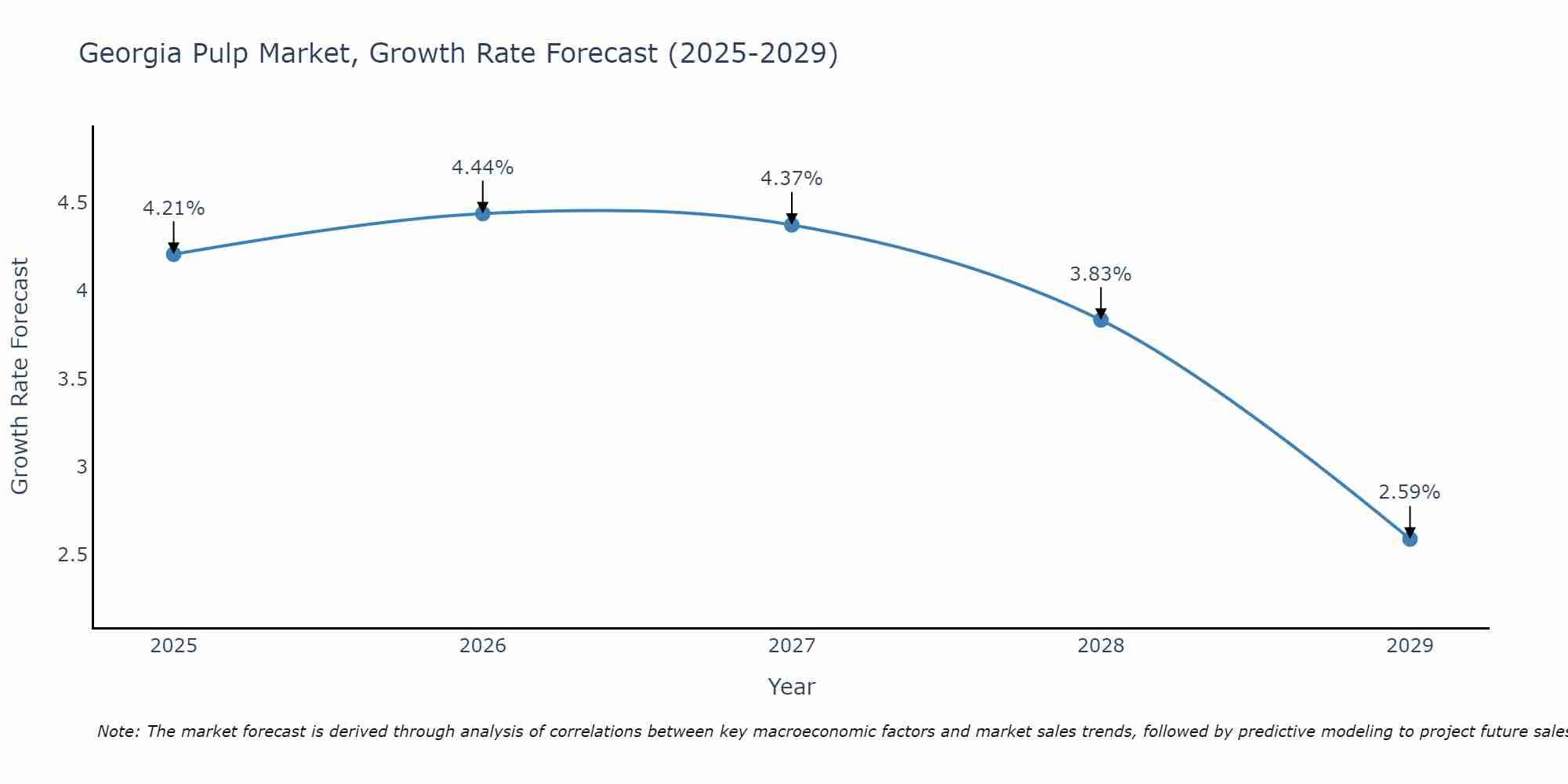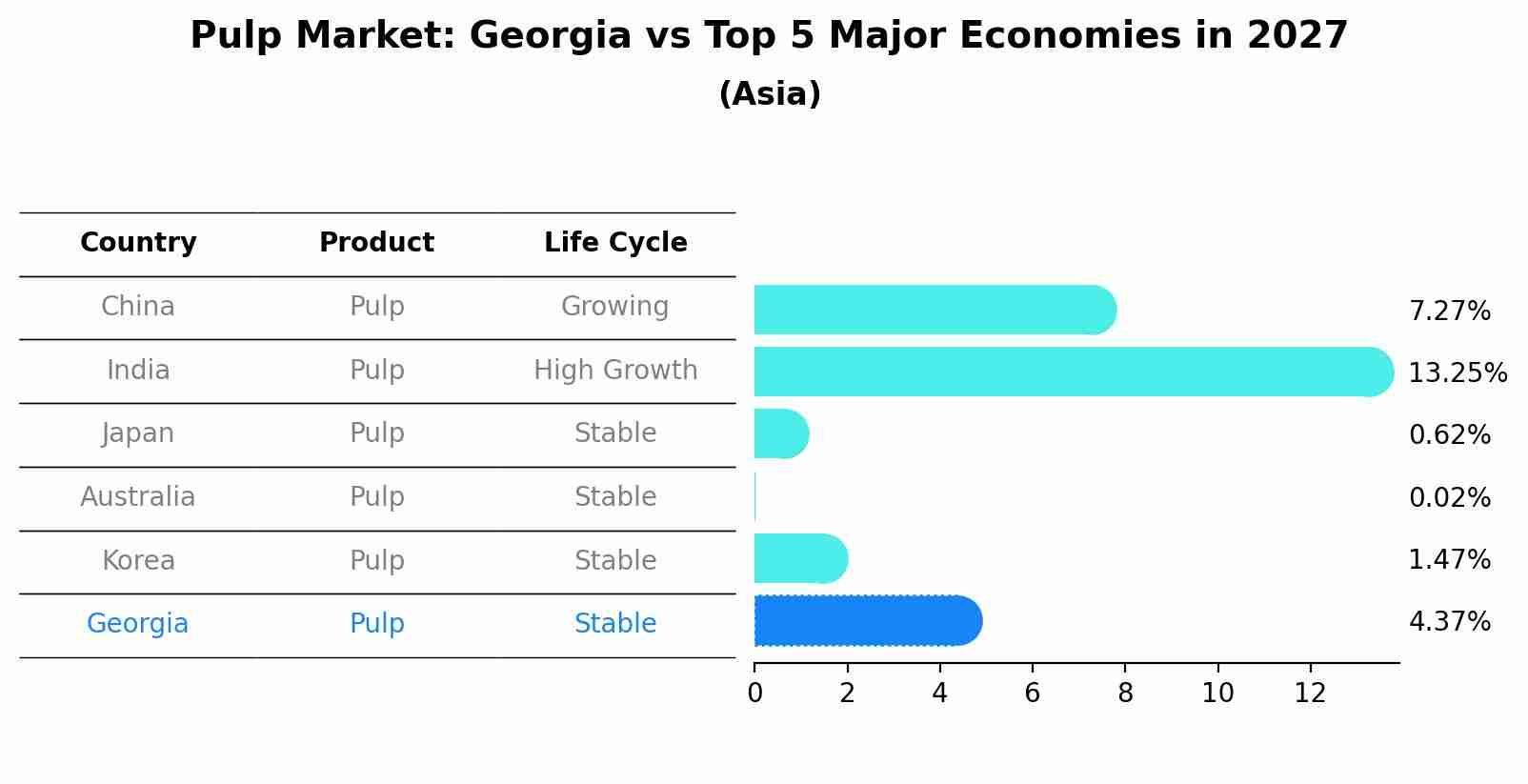Georgia Pulp Market (2025-2031) | Value, Growth, Share, Analysis, Outlook, Trends, Companies, Size, Industry, Revenue & Forecast
| Product Code: ETC007040 | Publication Date: Sep 2020 | Updated Date: Apr 2025 | Product Type: Report | |
| Publisher: 6Wresearch | Author: Ravi Bhandari | No. of Pages: 70 | No. of Figures: 35 | No. of Tables: 5 |
Georgia Pulp Market Size Growth Rate
The Georgia Pulp Market is projected to witness mixed growth rate patterns during 2025 to 2029. Starting at 4.21% in 2025, the market peaks at 4.44% in 2026, and settles at 2.59% by 2029.

Pulp Market: Georgia vs Top 5 Major Economies in 2027 (Asia)
By 2027, Georgia's Pulp market is forecasted to achieve a stable growth rate of 4.37%, with China leading the Asia region, followed by India, Japan, Australia and South Korea.

Georgia Pulp Market Overview
In Georgia, the pulp market plays a significant role in the forestry and paper industries, serving as a key raw material for the production of paper, packaging, and other paper-based products. Pulp is produced through mechanical or chemical processes from wood fibers, recycled paper, or agricultural residues. With abundant forest resources and a well-established pulp and paper industry, Georgia is a leading producer of pulp products in the United States. With increasing demand for sustainable packaging solutions and paper products, pulp manufacturers in Georgia are investing in modernization, efficiency improvements, and environmental stewardship, driving market growth and competitiveness in the region.
Drivers of the market
The Georgia Pulp Market is witnessing growth driven by factors such as the increasing demand for paper and packaging materials, sustainable forestry practices, and technological advancements in pulp production. Pulp is a key raw material used in the manufacture of various paper products, including printing and writing paper, tissue paper, and packaging materials. With the growing emphasis on eco-friendly packaging solutions and the rising e-commerce sector, the demand for pulp is on the rise in Georgia. Moreover, investments in pulp mill modernization, recycling infrastructure, and bio-based alternatives are driving innovation and market expansion as companies seek to meet customer demands for quality, cost-effective, and environmentally sustainable products.
Challenges of the market
The Georgia pulp market faces challenges related to sustainability, market volatility, and technological advancements. Pulp, a key raw material for paper and packaging industries, is produced through chemical or mechanical processes from wood fibers or recycled materials. However, ensuring sustainability in pulp production, including responsible forestry practices, resource efficiency, and waste reduction, poses challenges for pulp manufacturers and paper mills in terms of environmental compliance, certification requirements, and supply chain transparency. Moreover, navigating market volatility and price fluctuations in pulp markets, influenced by factors such as global demand, currency exchange rates, and trade policies, adds complexity to procurement strategies, inventory management, and financial planning. Additionally, adapting to technological advancements and market trends, such as digitalization, e-commerce packaging, and sustainable packaging solutions, requires investment in research and development, process innovation, and product differentiation. Furthermore, addressing regulatory changes and market preferences for eco-friendly products, such as recycled paper and biodegradable packaging, presents challenges in terms of compliance, product development, and customer education. Overcoming these challenges necessitates collaboration between pulp manufacturers, paper producers, and regulatory authorities to develop and adopt sustainable practices, innovative solutions, and industry standards in the Georgia pulp market.
Government Policy of the market
Georgia recognizes the importance of pulp in various industries, including paper manufacturing, packaging, and textiles. Policies aim to support the growth and sustainability of the pulp market by fostering innovation, sustainable forestry practices, and regulatory compliance. Regulatory frameworks address standards for pulp production, forest management, and environmental stewardship to ensure the integrity and sustainability of pulp supply chains. Additionally, support for research and development initiatives, technology transfer, and industry partnerships contributes to the advancement of pulp processing technologies in Georgia economy. By fostering collaboration between pulp producers, end-users, and regulatory agencies, Georgia aims to enhance its position as a supplier of high-quality pulp products and contribute to industrial efficiency, environmental sustainability, and economic development.
Key Highlights of the Report:
- Georgia Pulp Market Outlook
- Market Size of Georgia Pulp Market, 2024
- Forecast of Georgia Pulp Market, 2031
- Historical Data and Forecast of Georgia Pulp Revenues & Volume for the Period 2021-2031
- Georgia Pulp Market Trend Evolution
- Georgia Pulp Market Drivers and Challenges
- Georgia Pulp Price Trends
- Georgia Pulp Porter's Five Forces
- Georgia Pulp Industry Life Cycle
- Historical Data and Forecast of Georgia Pulp Market Revenues & Volume By Types for the Period 2021-2031
- Historical Data and Forecast of Georgia Pulp Market Revenues & Volume By Chemical Pulp for the Period 2021-2031
- Historical Data and Forecast of Georgia Pulp Market Revenues & Volume By Mechanical & Semi Chemical Pulp for the Period 2021-2031
- Historical Data and Forecast of Georgia Pulp Market Revenues & Volume By Non Wood Pulp for the Period 2021-2031
- Historical Data and Forecast of Georgia Pulp Market Revenues & Volume By Applications for the Period 2021-2031
- Historical Data and Forecast of Georgia Pulp Market Revenues & Volume By Corrugating Materials for the Period 2021-2031
- Historical Data and Forecast of Georgia Pulp Market Revenues & Volume By Printing & Writing for the Period 2021-2031
- Historical Data and Forecast of Georgia Pulp Market Revenues & Volume By Carton Board for the Period 2021-2031
- Historical Data and Forecast of Georgia Pulp Market Revenues & Volume By Tissue for the Period 2021-2031
- Historical Data and Forecast of Georgia Pulp Market Revenues & Volume By Newsprint for the Period 2021-2031
- Historical Data and Forecast of Georgia Pulp Market Revenues & Volume By Wrapping Paper for the Period 2021-2031
- Historical Data and Forecast of Georgia Pulp Market Revenues & Volume By Kraft Paper for the Period 2021-2031
- Georgia Pulp Import Export Trade Statistics
- Market Opportunity Assessment By Types
- Market Opportunity Assessment By Applications
- Georgia Pulp Top Companies Market Share
- Georgia Pulp Competitive Benchmarking By Technical and Operational Parameters
- Georgia Pulp Company Profiles
- Georgia Pulp Key Strategic Recommendations
Frequently Asked Questions About the Market Study (FAQs):
1 Executive Summary |
2 Introduction |
2.1 Key Highlights of the Report |
2.2 Report Description |
2.3 Market Scope & Segmentation |
2.4 Research Methodology |
2.5 Assumptions |
3 Georgia Pulp Market Overview |
3.1 Georgia Country Macro Economic Indicators |
3.2 Georgia Pulp Market Revenues & Volume, 2021 & 2031F |
3.3 Georgia Pulp Market - Industry Life Cycle |
3.4 Georgia Pulp Market - Porter's Five Forces |
3.5 Georgia Pulp Market Revenues & Volume Share, By Types, 2021 & 2031F |
3.6 Georgia Pulp Market Revenues & Volume Share, By Applications, 2021 & 2031F |
4 Georgia Pulp Market Dynamics |
4.1 Impact Analysis |
4.2 Market Drivers |
4.3 Market Restraints |
5 Georgia Pulp Market Trends |
6 Georgia Pulp Market, By Types |
6.1 Georgia Pulp Market, By Types |
6.1.1 Overview and Analysis |
6.1.2 Georgia Pulp Market Revenues & Volume, By Types, 2021-2031F |
6.1.3 Georgia Pulp Market Revenues & Volume, By Chemical Pulp, 2021-2031F |
6.1.4 Georgia Pulp Market Revenues & Volume, By Mechanical & Semi Chemical Pulp, 2021-2031F |
6.1.5 Georgia Pulp Market Revenues & Volume, By Non Wood Pulp, 2021-2031F |
6.2 Georgia Pulp Market, By Applications |
6.2.1 Overview and Analysis |
6.2.2 Georgia Pulp Market Revenues & Volume, By Corrugating Materials, 2021-2031F |
6.2.3 Georgia Pulp Market Revenues & Volume, By Printing & Writing, 2021-2031F |
6.2.4 Georgia Pulp Market Revenues & Volume, By Carton Board, 2021-2031F |
6.2.5 Georgia Pulp Market Revenues & Volume, By Tissue, 2021-2031F |
6.2.6 Georgia Pulp Market Revenues & Volume, By Newsprint, 2021-2031F |
6.2.7 Georgia Pulp Market Revenues & Volume, By Wrapping Paper, 2021-2031F |
7 Georgia Pulp Market Import-Export Trade Statistics |
7.1 Georgia Pulp Market Export to Major Countries |
7.2 Georgia Pulp Market Imports from Major Countries |
8 Georgia Pulp Market Key Performance Indicators |
9 Georgia Pulp Market - Opportunity Assessment |
9.1 Georgia Pulp Market Opportunity Assessment, By Types, 2021 & 2031F |
9.2 Georgia Pulp Market Opportunity Assessment, By Applications, 2021 & 2031F |
10 Georgia Pulp Market - Competitive Landscape |
10.1 Georgia Pulp Market Revenue Share, By Companies, 2024 |
10.2 Georgia Pulp Market Competitive Benchmarking, By Operating and Technical Parameters |
11 Company Profiles |
12 Recommendations |
13 Disclaimer |
- Single User License$ 1,995
- Department License$ 2,400
- Site License$ 3,120
- Global License$ 3,795
Search
Thought Leadership and Analyst Meet
Our Clients
Related Reports
- Germany Breakfast Food Market (2026-2032) | Industry, Share, Growth, Size, Companies, Value, Analysis, Revenue, Trends, Forecast & Outlook
- Australia Briquette Market (2025-2031) | Growth, Size, Revenue, Forecast, Analysis, Trends, Value, Share, Industry & Companies
- Vietnam System Integrator Market (2025-2031) | Size, Companies, Analysis, Industry, Value, Forecast, Growth, Trends, Revenue & Share
- ASEAN and Thailand Brain Health Supplements Market (2025-2031) | Strategy, Consumer Insights, Analysis, Investment Trends, Opportunities, Growth, Size, Share, Industry, Revenue, Segments, Value, Segmentation, Supply, Forecast, Restraints, Outlook, Competition, Drivers, Trends, Demand, Pricing Analysis, Competitive, Strategic Insights, Companies, Challenges
- ASEAN Bearings Market (2025-2031) | Strategy, Consumer Insights, Analysis, Investment Trends, Opportunities, Growth, Size, Share, Industry, Revenue, Segments, Value, Segmentation, Supply, Forecast, Restraints, Outlook, Competition, Drivers, Trends, Demand, Pricing Analysis, Competitive, Strategic Insights, Companies, Challenges
- Europe Flooring Market (2025-2031) | Outlook, Share, Industry, Trends, Forecast, Companies, Revenue, Size, Analysis, Growth & Value
- Saudi Arabia Manlift Market (2025-2031) | Outlook, Size, Growth, Trends, Companies, Industry, Revenue, Value, Share, Forecast & Analysis
- Uganda Excavator, Crane, and Wheel Loaders Market (2025-2031) | Strategy, Consumer Insights, Analysis, Investment Trends, Opportunities, Growth, Size, Share, Industry, Revenue, Segments, Value, Segmentation, Supply, Forecast, Restraints, Outlook, Competition, Drivers, Trends, Demand, Pricing Analysis, Competitive, Strategic Insights, Companies, Challenges
- Rwanda Excavator, Crane, and Wheel Loaders Market (2025-2031) | Strategy, Consumer Insights, Analysis, Investment Trends, Opportunities, Growth, Size, Share, Industry, Revenue, Segments, Value, Segmentation, Supply, Forecast, Restraints, Outlook, Competition, Drivers, Trends, Demand, Pricing Analysis, Competitive, Strategic Insights, Companies, Challenges
- Kenya Excavator, Crane, and Wheel Loaders Market (2025-2031) | Strategy, Consumer Insights, Analysis, Investment Trends, Opportunities, Growth, Size, Share, Industry, Revenue, Segments, Value, Segmentation, Supply, Forecast, Restraints, Outlook, Competition, Drivers, Trends, Demand, Pricing Analysis, Competitive, Strategic Insights, Companies, Challenges
Industry Events and Analyst Meet
Whitepaper
- Middle East & Africa Commercial Security Market Click here to view more.
- Middle East & Africa Fire Safety Systems & Equipment Market Click here to view more.
- GCC Drone Market Click here to view more.
- Middle East Lighting Fixture Market Click here to view more.
- GCC Physical & Perimeter Security Market Click here to view more.
6WResearch In News
- Doha a strategic location for EV manufacturing hub: IPA Qatar
- Demand for luxury TVs surging in the GCC, says Samsung
- Empowering Growth: The Thriving Journey of Bangladesh’s Cable Industry
- Demand for luxury TVs surging in the GCC, says Samsung
- Video call with a traditional healer? Once unthinkable, it’s now common in South Africa
- Intelligent Buildings To Smooth GCC’s Path To Net Zero


















